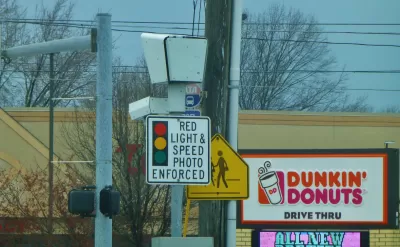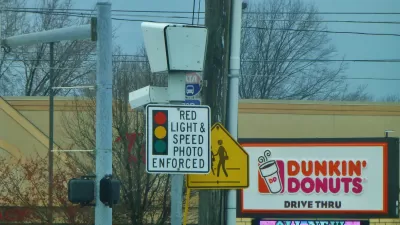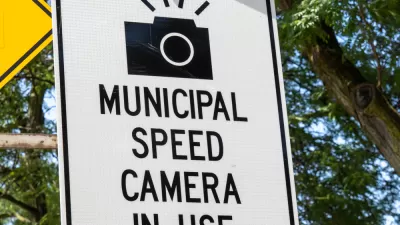Gov. Andrew M. Cuomo took his mother to work on Sunday so she could join him in a panel where he signed life-saving, street safety legislation to reinstate and expand the school zone speed camera program in New York City.

In an email titled, "To all the mothers in New York," sent, appropriately, on Mother's Day, the New York State governor writes, "Earlier today my mother joined me to sign life-saving legislation to expand camera speed zones in New York City."
"Speed cameras work - it is just undeniable," states Gov. Andrew M. Cuomo in the video of the panel discussion on May 12 that preceded his signing two bills, S.4331 by Sen. Andrew Gounardes (D-Brooklyn) and A.6449 by Assemblymember Deborah J. Glick (D-Manhattan), to continue and expand the operation of photo speed violation monitoring systems in school speed zones in New York City.
Since the activation of the cameras, the number of people killed or severely injured in crashes in school zones with speed cameras declined by 21 percent, and the rate of daily violations for excessive speeding has declined by over 60 percent.
"This bill will increase the number from 140 to 750 speed cameras in the city, extend the hours of operation of the speed cameras and will mandate that the city prioritize placement of the cameras by speed and crash data," states Cuomo.
A 2015 post about a study on the effectiveness of speed cameras in Montgomery County, Md., confirms Cuomo's afore-mentioned assertion.
“Speed cameras get drivers to ease off the accelerator, and crashes are less likely to be deadly at lower speeds,” said Insurance Institute for Highway Safety President Adrian Lund. “This study connects the dots to show that speed cameras save lives.”
The governor's press release (source article) recounts the legislative history of this particular type of automated traffic enforcement.
This legislation reinstates and expands a bill signed by the Governor in 2013 authorizing the city to develop the program using camera technology to record and enforce speeding violation in school zones. Upon the program's expiration in July 2018, and after the Republican-controlled Senate failed to extend the authority before the end of the legislative session, Governor Cuomo signed an executive order [declaring a "state of emergency"] allowing the city to impose the same fines authorized under the expired law and access data from the DMV to carry out the program for the 2018-19 school year.
Also on the panel was Amy Cohen, a safe streets activist who lost her 12-year-old son in a traffic crash in 2013 in Park Slope, Brooklyn, and now works with Families for Safe Streets and Transportation Alternatives to fight for safer streets.
"This is a historic moment recognizing that traffic violence is preventable, and it could never have happened without the leadership of Gov. Cuomo," said Cohen.
California bill stalled
On the West Coast, speed camera legislation that would have authorized a pilot program in Northern California's two largest cities, San Jose and San Francisco, was DOA at its second committee hearing in January 2018. California lacks laws permitting automated speed enforcement, notes an earlier post on the bill.
Related on Planetizen:
-
San Francisco and San Jose Propose Joint Pilot Program for Speed Cameras, February 11, 2017
-
Speed Cameras Have Proven Record of Reducing Speeding, New Study Says, September 3, 2015

Trump Administration Could Effectively End Housing Voucher Program
Federal officials are eyeing major cuts to the Section 8 program that helps millions of low-income households pay rent.

Planetizen Federal Action Tracker
A weekly monitor of how Trump’s orders and actions are impacting planners and planning in America.

Ken Jennings Launches Transit Web Series
The Jeopardy champ wants you to ride public transit.

Rebuilding Smarter: How LA County Is Guiding Fire-Ravaged Communities Toward Resilience
Los Angeles County is leading a coordinated effort to help fire-impacted communities rebuild with resilience by providing recovery resources, promoting fire-wise design, and aligning reconstruction with broader sustainability and climate goals.

When Borders Blur: Regional Collaboration in Action
As regional challenges outgrow city boundaries, “When Borders Blur” explores how cross-jurisdictional collaboration can drive smarter, more resilient urban planning, sharing real-world lessons from thriving partnerships across North America.

Philadelphia Is Expanding its Network of Roundabouts
Roundabouts are widely shown to decrease traffic speed, reduce congestion, and improve efficiency.
Urban Design for Planners 1: Software Tools
This six-course series explores essential urban design concepts using open source software and equips planners with the tools they need to participate fully in the urban design process.
Planning for Universal Design
Learn the tools for implementing Universal Design in planning regulations.
Ada County Highway District
Clanton & Associates, Inc.
Jessamine County Fiscal Court
Institute for Housing and Urban Development Studies (IHS)
City of Grandview
Harvard GSD Executive Education
Toledo-Lucas County Plan Commissions
Salt Lake City
NYU Wagner Graduate School of Public Service




























